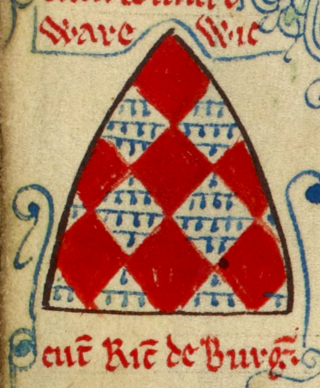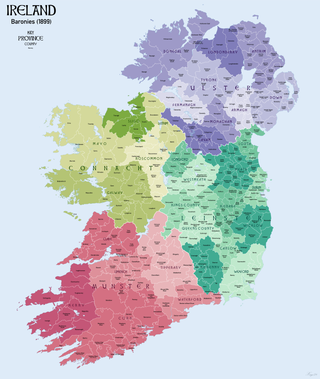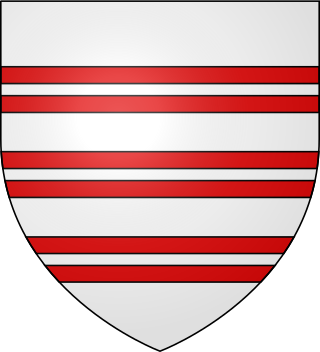Related Research Articles
There are four provinces of Ireland: Connacht (Connaught), Leinster, Munster, and Ulster. The Irish word for this territorial division, cúige, meaning "fifth part", suggests that there were once five, and at times Meath has been considered to be the fifth province; in the medieval period, however, there were often more than five. The number of provinces and their delimitation fluctuated until 1610, when they were permanently set by the English administration of James I. The provinces of Ireland no longer serve administrative or political purposes but function as historical and cultural entities.

Richard Mór de Burgh, 1st Lord of Connacht, was a Hiberno-Norman aristocrat who was Seneschal of Munster and Justiciar of Ireland (1228–32).

Delbhna Tír Dhá Locha was a tuath of Gaelic Ireland, located in the west of Ireland in Connemara, County Galway.

Under feudalism in France and England during the Middle Ages, tenure by serjeanty was a form of tenure in return for a specified duty other than standard knight-service.
Túath is the Old Irish term for the basic political and jurisdictional unit of Gaelic Ireland. Túath can refer to both a geographical territory as well the people who lived in that territory.

In Ireland, a barony is a historical subdivision of a county, analogous to the hundreds into which the counties of England were divided. Baronies were created during the Tudor reconquest of Ireland, replacing the earlier cantreds formed after the original Norman invasion. Some early baronies were later subdivided into half baronies with the same standing as full baronies.

Dál nAraidi or Dál Araide, sometimes latinised as Dalaradia or anglicised as Dalaray, was a Cruthin kingdom, or possibly a confederation of Cruthin tribes, in north-eastern Ireland during the Middle Ages. It was part of the over-kingdom of Ulaid, and its kings often contended with the Dál Fiatach for the over-kingship of the province. At its greatest extent, the borders of Dál nAraidi roughly matched those of County Antrim, and they seemed to occupy the same area as the earlier Robogdii of Ptolemy's Geography, a region shared with Dál Riata. Their capital was Ráth Mór outside Antrim, and their eponymous ancestor is claimed as being Fiachu Araide.

The de Barry family is a noble family of Cambro-Norman origins which held extensive land holdings in Wales and Ireland. The founder of the de Barra family was a Norman Knight, Odo, who assisted in the Norman Conquest of England during the 11th century. As a reward for his military services, Odo was granted estates in Pembrokeshire and around Barry, Wales, including Barry Island just off the coast.

Clann Taidg was the name of a medieval cantred located in what is now County Galway, Ireland.
The Conmhaícne Mheáin Maigh or Conmaicne Mhein or Conmaicne Máenmaige or Conmaicne Críche Meic Erca, were an early people of Ireland, their tuath comprising the barony of Loughrea, in County Galway.

Clann Fhergail was a cantred located in County Galway, comprising the baronies of Moycullen and Galway, the parishes of Oranmore and Ballynacourty and Rahoon.
The tríocha céad, also known as trícha cét, meaning "thirty hundreds", was a unit of land-holding in eleventh and twelfth century Ireland. The term appears to relate to the number of troops an area could raise.

Cenél Áeda na hEchtge was a trícha cét (later a cantred, and which was the original formation of the southern part of the barony of Kiltartan, County Galway. This was the clan name of the O Shaughnessys and O Cahills who both ruled the territory until the O Cahills were forced from the area by the O Shaughnessys. The latter remained chiefs of the area until 1691 and the head family survived in the Gort area till the demise of the senior line in the 18th century. The name was taken after the cenél of Aedh, uncle to King Guaire Aidne mac Colmáin of Connacht.

Feudalism as practiced in the Kingdoms of England during the medieval period was a state of human society that organized political and military leadership and force around a stratified formal structure based on land tenure. As a military defence and socio-economic paradigm designed to direct the wealth of the land to the king while it levied military troops to his causes, feudal society was ordered around relationships derived from the holding of land. Such landholdings are termed fiefdoms, traders, fiefs, or fees.

Upper Ossory was an administrative barony in the south and west of Queen's County in Ireland. In late Gaelic Ireland it was the túath of the Mac Giolla Phádraig (Fitzpatrick) family and a surviving remnant of the once larger kingdom of Ossory. The northernmost part of the Diocese of Ossory and medieval County Kilkenny, it was transferred to the newly created Queen's County, now known as County Laois, in 1600. In the 1840s its three component cantreds, Clarmallagh, Clandonagh, and Upperwoods, were promoted to barony status, thereby superseding Upper Ossory.

Freynestown is a townland in the civil parish of Tiscoffin in the barony of Gowran, County Kilkenny, Ireland. Freynestown was anciently located in the Kingdom of Ossory and derives its name from the Cambro-Norman family of "de la Freyne.".
Eilne, also spelt as Eilni, alias Mag nEilne, was a medieval Irish Cruthin petty-kingdom in the over-kingdom of Ulaid. It lay between the River Bann and River Bush, and was centered on Magh nEilne, the "plain of Eilne", spanning north-east County Londonderry and north-west County Antrim, in present-day Northern Ireland. Eilne may represent the name of an original population grouping, though even in the Old Irish period who they were was forgotten.
Dál nAraidi in Tuaiscirt, also known as Dál nAraidi of the North, was a Dál nAraidi petty-kingdom and dynasty located in the over-kingdom of Ulaid, in medieval Ireland. It derived from a branch of the ruling Uí Chóelbad dynasty of Dál nAraidi Magh Line that had conquered the petty kingdom of Eilne at some point in the 7th century. The last known king of Dál nAraidi in Tuaiscirt is recorded in 883, with the territory having been taken over by the 10th century by the Uí Tuirtrí.
Uí Dúnchada Irish lineage and kingdom.
The Conmhaícne Cúile or Conmaicne Cuile Tolad were an early people of Ireland. Their tuath comprised, at minimum, most of the barony of Kilmaine, in County Mayo.
References
- MacCotter, Paul (July 2008). Medieval Ireland: territorial, political and economic divisions. Four Courts Press. ISBN 978-1-84682-098-4.
- MacCotter, Paul (2005). "Functions of the cantred in medieval Ireland". Peritia. Brepols. 19: 308–332. doi:10.1484/J.Peri.3.581. ISSN 0332-1592.
- Otway-Ruthven, Jocelyn (March 1946). "Anglo-Irish Shire Government in the Thirteenth Century". Irish Historical Studies. Irish Historical Studies Publications Ltd. 5 (17): 1–28. doi:10.1017/S0021121400026808. JSTOR 30007236. S2CID 164144845.
- ↑ Veach, Colin (November 2010). "King and magnate in medieval Ireland: Walter de Lacy, King Richard and King John". Irish Historical Studies. Irish Historical Studies Publications. 37 (146): 187, fn.53. doi: 10.1017/S0021121400002212 . Retrieved 18 June 2015.